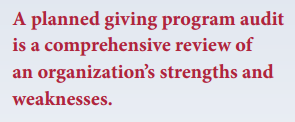By: John Jensen
Unlike major or annual giving programs, the results of current planned giving efforts may not be seen for a period of time. As a result, it can sometimes be difficult to determine if a planned giving program is working as it should. That’s why getting an outside look can often be helpful.
A planned giving program audit is a comprehensive review of an organization’s strengths and weaknesses. Audits are a way of discovering valuable information that can help drive your current and future marketing and donor cultivation efforts.
What’s involved in a planned giving audit?
A planned giving program audit analyzes all aspects of a program. Steps include:
- Interviewing staff and senior management
- Analyzing a series of multi-dimensional database reports to determine if gifts and estates are being handled systematically and proactively

- Examining estate administration and gift acceptance policies and suggesting improvements where appropriate
- Comparing the organizational experience with industry norms
- Evaluating marketing materials and communication strategies to determine if they are appropriate and effective for your donors
- Examining age and demographics of current and deceased members of a donor recognition society to determine effective stewarding practices
- Reviewing and analyzing an appropriate number of realized bequests to determine important metrics such as how many other charities are named in estates, whether any appear repeatedly and the ratio of residual to specific bequests
Addressing challenges
One common problem in many organizations is that senior managers often have little direct experience with planned giving and, as a result, can have unrealistic expectations as to both potential and appropriate cost factors. An audit can bring perspective to senior management regarding how a program succeeds over time and can help set reasonable expectations.
Organizations often forego significant revenue because of ineffective estate management. It is estimated that charities may lose as much as 25 percent of an intended bequest between the donor’s death and the time the estate is settled. This happens as a result of many sources of “leakage” a charity will never recognize unless staff members are vigilant and know what to look for.
Other charities incrementally move staff time and resources away from planned giving in favor of more short-term goals such as events and campaigns. This is a common mistake, and often management does not understand the real economic loss associated with neglect of important but less obvious uses of staff resources.
In the world of planned giving, expectations and results don’t always match. Issues not discovered and addressed can worsen and result in even more missed opportunities.
An outside assessment can help management tune up a program to ensure your donors don’t forget how much they value your mission when they are considering the philanthropic aspect of their estate and financial plans.

